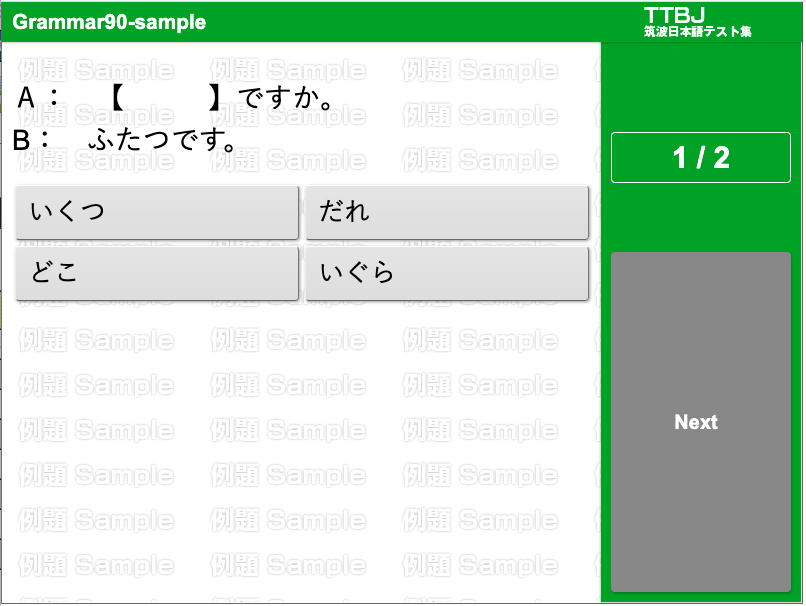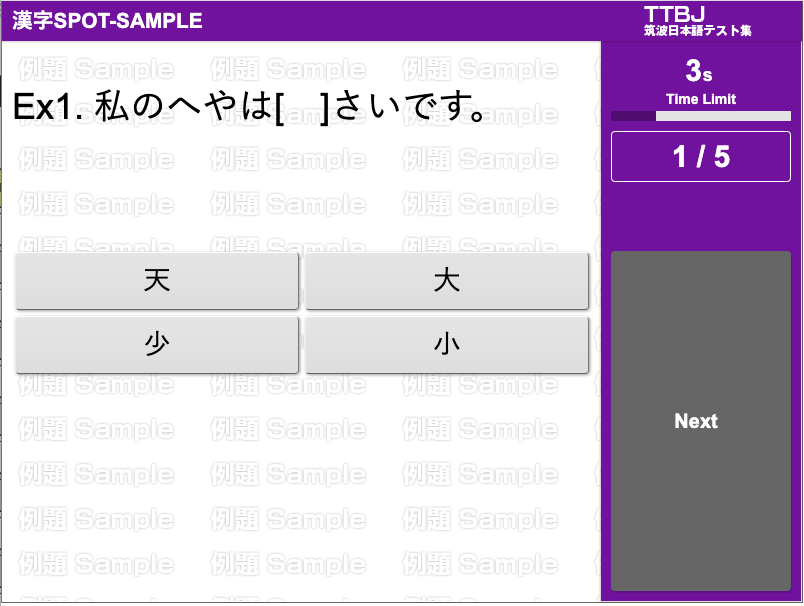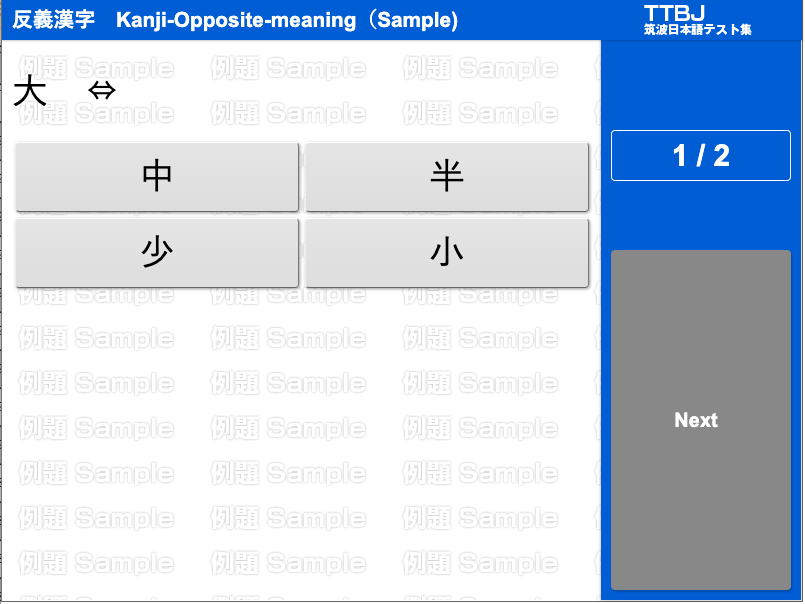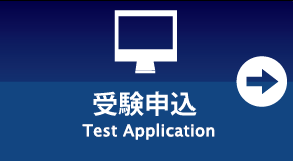
Please check the content of the Terms of Use.
Taking the TTBJ for Individuals
"naver.com" and "qq.com" addresses may not receive emails.
Overview
About the TTBJ (Tsukuba Test-Battery of Japanese)
The TTBJ is comprised of various different kinds of questions. Based on the objective of the test, questions can be roughly divided into two types: (1) Placement tests and (2) Diagnostic tests. Currently, the TTBJ provides SPOT and Kanji SPOT as placement tests, and Kanji Diagnostic Tests as diagnostic tests. SPOT is a unique test that enables measurement of examinees’ Japanese language proficiency in a short period of time. Accordingly, it is used widely both in Japan and overseas for not only placement tests but also assessment of Japanese language ability for study and research. Kanji Diagnostic Tests can be useful for language learning, providing graphs indicating an examinee’s areas of weakness within their kanji skills. Other tests are also scheduled for future release.
Recommended test sets that are used by The University of Tsukuba are available. Individual tests can also be selected.
Test sets
SPOT90 + Grammar90 + Kanji SPOT50
Test times: 30 – 60 minutes
The TTBJ is used by the University of Tsukuba as a placement test. For several years, the University of Tsukuba has been using the TTBJ Test for Individuals to sort more than 1,000 students into appropriate Japanese language class levels every year. We recommend asking students to take the set of tests individually and then present the results sent to them via PDF file to your learning institution. If you wish to use the TTBJ test in the same manner, please refer to the Test Manual, which is available on the website of the Japanese Language Education Division of the Center for Education of Global Communication, The University of Tsukuba (http://www.cegloc.tsukuba.ac.jp/data/doc/1467349914_doc_83_0.pdf).
Individual tests
SPOT90 (90 questions; 10–15 minutes)
Grammar90 (90 questions; 15–30 minutes)
Kanji SPOT50 (50 questions; 10–15 minutes)
Kanji Diagnostic Test (Beginners Level) (120 questions; 40–60 minutes)
Kanji Diagnostic Test (Intermediate Level) (120 questions; 30–48 minutes)
Kanji Diagnostic Test (Advanced Level) (120 questions; 20–36 minutes)
What kind of test is SPOT?
A sentence is displayed on the screen. Within the sentence is a blank space enclosed in brackets. At the same time as the sentence appears on the screen, it is also read aloud. As you listen to the sentence being read aloud, select the hiragana that goes in the brackets from the four answer options. Response time is very short.

What does the test measure?
Even if you can understand a sentence that you read or hear if you take time to think about it, it is impossible to communicate with others in real life if you cannot understand the meaning in real time. Because the objective of this test is to estimate the skills that examinees can actually use in real life, the sentences/phrases may seem slightly difficult to hear or the response time too short, but if you have sufficient Japanese language ability, you should have no difficulty hearing the sentence/phrase and should find the response time to be sufficient.
Types of SPOT Tests
There is only one type of SPOT test available to Individual examinees. Known as “Ver. 90”, this test comprises 90 questions ranging from Beginner to Advanced level and is divided into three sections: 90-1, 90-2, and 90-3.
What kind of test is Grammar 90?
This test measures knowledge of grammar. Examinees select appropriate words to insert into blank spaces within sentences. The sentences are all unrelated, standing alone. Depending on the language level, furigana readings are written above difficult kanji characters. Grammar 90 is comprised of three sections, with 90 questions in total. The response time for each section (30 questions each) is 10 minutes, with a total response time of 30 minutes for the three sections. Examinees may answer the questions at their own pace. If an examinee encounters a question they cannot answer, they should click the → (Next) button to proceed to the next question, continuing on to the end of the test.
Test Examples
A screen similar to the one shown below will be displayed. Select one answer from the options shown.

Test Composition
Grammar90 is comprised of three sections of varying degrees of difficulty. There are 30 questions in each section. Grammar90-1 has a low degree of difficulty, while Grammar90-3 has a high degree of difficulty.
What kind of test is Kanji SPOT50?
A sentence is displayed on the screen. Within the sentence is a blank space enclosed in brackets. At the same time as the sentence appears on the screen, it is also read aloud. As you listen to the sentence being read aloud, select the kanji character that goes in the brackets from the four answer options. Response time is very short.

What does the test measure?
Even if you can understand a kanji word that you read or can visualize the kanji character for a word that you hear if you take time to think about it, it is impossible to utilize your knowledge effectively in real life if you cannot understand it immediately. Because this test was devised with the objective of estimating the kanji vocabulary that examinees can actually use in real life, the response time may seem slightly too short for reading a sentence/phrase while listening to it being spoken, but if you have sufficient Japanese language ability, you should find the response time to be sufficient.
Types of Kanji SPOT50 tests
There is only one type of Kanji SPOT test available to Individual examinees. This test is comprised of 50 questions in total: 20 questions for the Beginner level and 30 questions for the Intermediate and Advanced levels.
What kind of test is the Kanji Diagnostic Test?
The test is comprised of 12 sections. Each section comprises 10 questions for a total of 120 questions. Some Advanced level questions require answers to be input, but for the Beginners and Intermediate level tests, all questions are multiple-choice questions with four answer options. Some of these questions require you to listen to audio information to answer. The response time for each section is 5 minutes or less at the Beginners level; four minutes or less at the Intermediate level; and three minutes or less at the Advanced level. If you answer the questions quickly, you will finish the test early; even if you answer the questions slowly, the test finishes within 60 minutes.

What does the test measure?
This test comprehensively analyzes your knowledge and proficiency with regard to kanji characters and kanji words, identifying your areas of weakness. The test does more than simply measure how many kanji you know, or can read, or can write, so please use the knowledge that you have to answer questions even when a kanji character you have not yet learned appears. The test can be regarded as providing useful information for your kanji study going forward.
Types of Kanji Diagnostic Tests
Beginner Level Kanji Diagnostic Test
The Beginner Level Kanji Diagnostic Test assumes examinees have completed study of around 200 basic kanji characters (equivalent to Japanese Language Proficiency Test N4 – N3).
- Questions where examinees select kanji characters with the opposite meaning to the kanji character shown
- Questions where examinees select the reading of a “kanji word” within a sentence
- Questions where examinees select a kanji character with the same onyomi reading as the kanji character shown
- Questions where examinees select a kanji character matching a “word” within a sentence
- Questions where examinees select components of a kanji character
- Questions where examinees select a kanji character matching the okurigana shown
- Questions where examinees select an appropriate form depending on the part of speech of a kanji word
- Questions where examinees select an appropriate kanji word depending on the context (grammatical co-occurrence)
- Questions where examinees select an appropriate kanji word depending on the context (semantic collocation knowledge)
- Questions where examinees select the kanji character common to three kanji words that they hear spoken aloud
- Questions where examinees select the kanji word with the meaning given them through audio information
- Questions where examinees select kanji character structural patterns
Intermediate Level Kanji Diagnostic Test
The Intermediate Level Kanji Diagnostic Test assumes examinees have completed studying around 500 kanji characters from the Basic Kanji Book Vol. 1 & 2 (equivalent to Japanese Language Proficiency Test N3 – N2).
- Questions where examinees select kanji characters with the opposite meaning to the kanji character shown
- Questions that divide kanji characters into units of meaning
- Questions where examinees select the reading of a “kanji word” within a sentence
- Questions where examinees select a kanji character with the same onyomi reading as the kanji character shown
- Questions where examinees select a kanji character matching a “word” within a sentence
- Questions where examinees select the radical of a kanji character
- Questions where examinees select a kanji character matching the okurigana shown
- Questions where examinees select an appropriate form depending on the part of speech of a kanji word
- Questions where examinees select an appropriate kanji word depending on the context (grammatical co-occurrence/semantic collocation knowledge)
- Questions where examinees select the kanji character common to three kanji words that they hear spoken aloud
- Questions where examinees select the kanji word with the meaning given them through audio information
- Questions where examinees select related kanji characters based on a kanji’s meaning, part of speech, reading, and form, etc.
Advanced Level Kanji Diagnostic Test
The Advanced Level Kanji Diagnostic Test assumes examinees have completed studying around 1,000 kanji characters from the Intermediate Kanji Book Vol. 1 (equivalent to Japanese Language Proficiency Test N2 – N1).
- Questions where examinees select antonyms for native Japanese words and kanji words
- Questions where examinees select synonyms for native Japanese words and kanji words
- Questions where examinees select the reading of a “kanji word” within a sentence
- Questions where examinees select a kanji character with the same onyomi reading as the kanji character shown
- Questions where examinees select homophone kanji from a list of vocabulary
- Questions where examinees select notation for onyomi words in a sentence/phrase
- Questions where examinees select notation for kunyomi words in a sentence/phrase
- Questions where examinees select an appropriate kanji word depending on the context (grammatical co-occurrence/semantic collocation knowledge)
- Questions where examinees select an appropriate native Japanese word depending on the context (grammatical co-occurrence/semantic collocation knowledge)
- Questions where examinees select the kanji character common to three kanji words that they hear spoken aloud
- Questions where examinees listen to a sentence and a question and then select the kanji word that answers the question
- Questions where examinees listen to a sentence and then input the kanji word that is repeated
 The following system environments are required in order to take TTBJ tests.
The following system environments are required in order to take TTBJ tests.
| OS | Windows 8.1 or above / Mac OS X or above |
|---|---|
| Internet browser | Edge, Google Chrome |
| Monitor | Resolution of 1024×768 or higher |
| Other requirements |
Must be able to play audio files. JavaScript must be enabled. Must have an internet connection speed (high-speed connection) capable of playing videos. |

- Apply to take the test: Once your system requirements have been confirmed, please enter your name and e-mail address. If your test results are to be sent to a designated recipient, please also enter the e-mail address of that recipient. Your test results will also be sent to this e-mail address.
- Receive e-mail: Your ID and password for taking the test will be sent to your registered e-mail address.
- Log in: Log in to the test system via the internet.
- Take the test: A question will appear on the screen, so please begin the test.
- Grading: Your test results will be displayed on the screen. In addition, after you have completed all of the questions, you will be able to download a PDF file of your results.
- Press the “Start” button displayed on the screen to start the test.
- An example question is provided before the test to allow you to practice answering, and you may practice with the example multiple times.
- Once the test has begun, it is not possible to go back to a previous page.
- Once the test has begun, be very careful not to click the browser’s “Back” button, as this will cause the program to close prematurely.
- Answer options may be re-selected multiple times within the prescribed response time.
- Answer options that are selected before you press the “Next” button or that are selected before “Time-over” are stored as a new answer.
- If you encounter a question you cannot answer, you should click the → (Next) button to proceed to the next question.
- When the last question has been completed, your results will be automatically displayed.
- To proceed to the next question set, please select “Next”.
- When finishing a section and proceeding to the next section, please click the “Close” button.
When the entire test has been completed, (1) “Show test score graph” and (2) “Download PDF of results” pages will appear.

The “Show test score graph” page will display a test score graph showing your correct answer rates. If your correct answer rate is 70% or lower, the graph will be shown in red. The red indicates your areas of weakness, so please use these results to devise study methods that will help you strengthen these areas of weakness and utilize them in your kanji study going forward. The “Download PDF of results” page displays a list of all your results for the test.

In the Kanji Diagnostic (Beginner) Test, a “Next” button leading to the Advice page will appear after your test results history. If you click this button, advice tailored to your test results for each of five evaluation categories (kanji reading, writing, usage, semantic processing, and audio processing) will be displayed.
Interpretation of scores
| Total score | Ability assessment* | Explanation | Correspondence with the Japanese Language Proficiency Test** |
|---|---|---|---|
| 0–30 | Introductory level | Learner has studied virtually no Japanese. | None |
| 31–55 | Beginner level | Can understand basic Japanese in everyday situations if spoken to slowly. | N4,N5 |
| 56–80 | Intermediate level | Can understand Japanese to a certain degree in everyday situations when spoken to at a natural speed. | N3,N2 |
| 81–90 | Advanced level | Can understand Japanese in a broad range of situations when spoken to at a natural speed. | N1 |
- *This is a guide for interpreting scores; it is not an absolute standard.
- **Correspondence with the Japanese Language Proficiency Test does not guarantee that examinees will pass. Please understand that this is only an approximation.
| Total score | Ability assessment* | Explanation | Correspondence with the Japanese Language Proficiency Test** |
|---|---|---|---|
| 0–20 | Novice beginner level | Learner has studied virtually no Japanese. | None |
| 21–50 | Beginner level | Learner has a beginner-level knowledge of grammar and can understand simple Japanese using a limited vocabulary. | N4,N5 |
| 51–80 | Intermediate level | Learner has an intermediate-level knowledge of grammar and can understand Japanese used in everyday situations. | N3,N2 |
| 81–90 | Advanced level | Learner has an advanced-level knowledge of grammar and can broadly understand Japanese. | N1 |
- *This is a guide for interpreting scores; it is not an absolute standard.
- **Correspondence with the Japanese Language Proficiency Test does not guarantee that examinees will pass. Please understand that this is only an approximation.
| Total score | Ability assessment* | Explanation | Correspondence with the Japanese Language Proficiency Test** |
|---|---|---|---|
| 0–15 | Introductory level | Learner either has studied virtually no kanji, or has only just begun studying (knows around 100 kanji characters) | None, or N5 |
| 16–30 | Beginner level | Learner has studied approx. 300–500 kanji characters from Basic Kanji Book Vol. 1 & 2. |
N4 |
| 31–40 | Immediate level | Learner has studied approx. 740 kanji characters up to Intermediate Kanji Book Vol. 1. | N3,N2 |
| 41–50 | Advanced level | Learner has studied approx. 1,200 kanji characters up to Intermediate Kanji Book Vol. 2. | N1 |
- *This is a guide for interpreting scores; it is not an absolute standard. (Especially in the case of learners from countries that use Chinese characters, it is possible for examinees to obtain reasonably high scores without having studied kanji as Japanese characters.)
- **Correspondence with the Japanese Language Proficiency Test does not guarantee that examinees will pass. Please understand that this is only an approximation.
Please check the content of the Terms of Use.
Taking the TTBJ for Individuals
Please make inquiries via e-mail.

